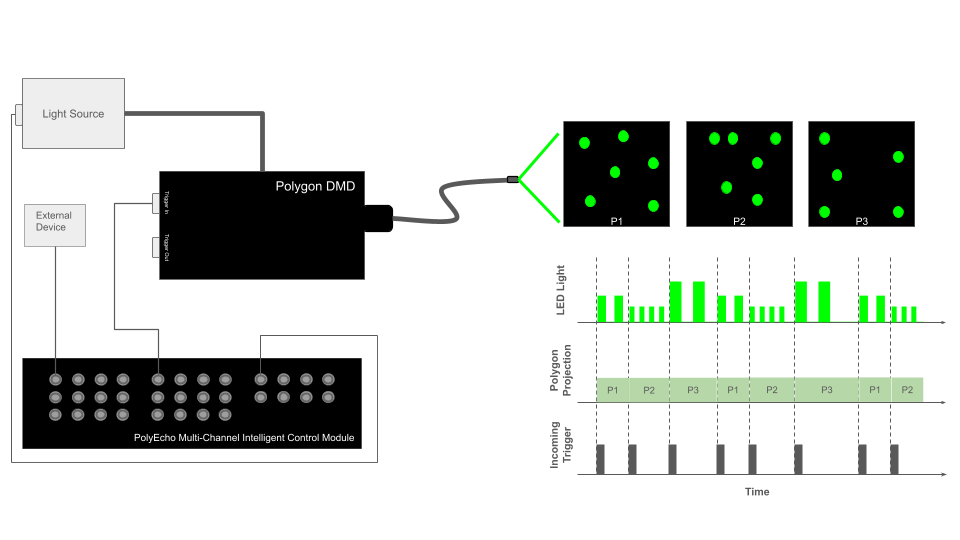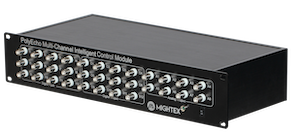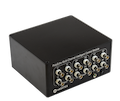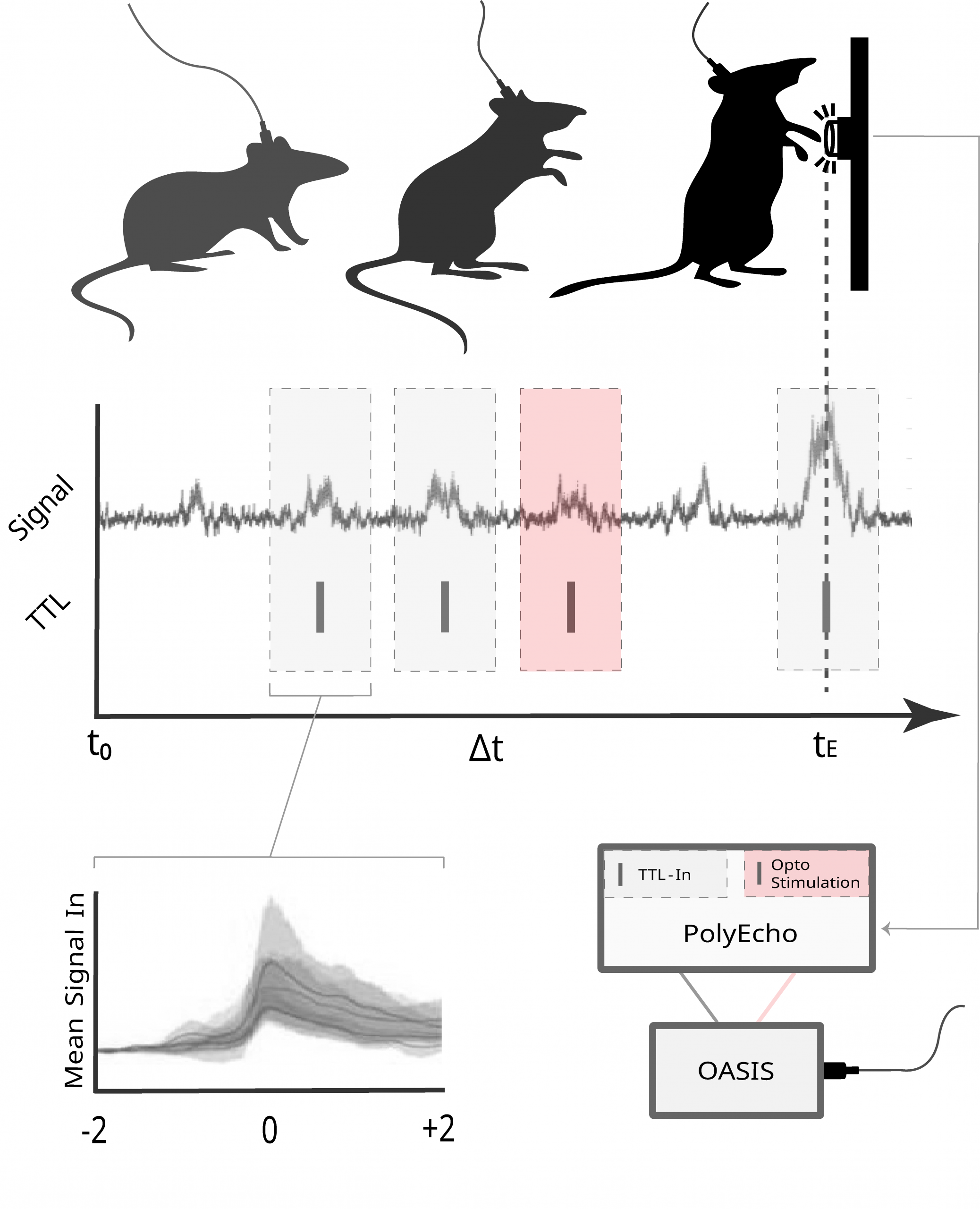
How to Synchronize the Polygon with Your Experiments
Scientific research relies on sophisticated multi-modal experimental approaches that integrate several complementary techniques to provide comprehensive insights into complex processes. Each experimental component requires specialized instrumentation, and the precise temporal synchronization of these devices is critical for generating meaningful, interpretable data.
In neuroscience, behavioral monitoring apparatus is frequently combined with calcium imaging systems and optogenetic light sources to simultaneously track neural activity and manipulate specific neuronal populations during behavioral tasks. Similarly, cell biology experiments often integrate live-cell tracking mechanisms with optical stimulation systems, such as combining fluorescence microscopy to monitor cellular dynamics (organelle movement, protein localization, or cell division) with precisely timed optogenetic activation of signaling pathways or photocaging/uncaging of cellular compounds.
The precise temporal synchronization of these diverse experimental components is crucial because biological responses often occur on millisecond to second timescales. Without proper coordination, researchers cannot accurately establish causal relationships between interventions and cellular responses. This synchronization is essential for meaningful data analysis and prevents misinterpretation of fundamental biological mechanisms.
Our Polygon DMD for targeted optogenetic stimulation can easily be synchronized with other devices using the Trigger In and Trigger Out ports available at the back of the Polygon. When used in the External Trigger Mode, the user can simply upload pre-designed patterns onto the Polygon and use an external trigger to switch from one pattern to the next. This external trigger should be connected to the Trigger In port of the Polygon. Once data acquisition starts, each new TTL pulse that is detected from the Trigger In port will trigger the Polygon to project the next pattern in the uploaded sequence.

As described in our previous blogpost, with Mightex’s PolyEcho I/O control module, users can simultaneously trigger the Polygon and other devices like LEDs with a single incoming trigger. With the PolyScan software, each incoming trigger can be used to program trigger-specific events. Eg. one can selectively trigger red and green LEDs to project specific patterns over different neuronal subpopulations using the Polygon.
In all, there are different ways to control the Polygon and synchronize pattern projection either directly through the trigger ports or using the PolyScan software along with the PolyEcho I/O control module. To learn more about the optimal way to use your Polygon DMD, find our support tutorials here or reach out to our customer support team here.
Megha Patwa, PhD Applications Specialist at Mightex
Published on 2025/08/29
Research powered by
Mightex’s PolyEcho


Neuroscientists often rely on carefully designed behavioural experiments to understand how the brain executes decision-making, learning, motor activity, and more. In preclinical studies, these experiments usually employ behavioural tasks designed to examine individual psychological concepts such as motivation. These tasks measure specific actions—such as pressing a lever, navigating a maze, or responding to a stimulus. Each event, whether it’s a stimulus being presented or a response being made, is logged by hardware and software with a precise time marker. This allows scientists to track not only what happens, but also when it happens, revealing patterns such as intervals between actions, or how quickly animals learn new tasks. A powerful way to analyze these behaviours is in a temporally-specific manner. That is, by correlating the timing of behavioural events with neuronal activity, scientists can begin to make connections between brain and behaviour.

By synchronizing these behavioral time stamps with other biological data, like neurotransmitter fiber photometry or cellular resolution calcium imaging, researchers can uncover how brain activity aligns with observable actions. For example, a time stamp of when an animal presses a lever can be matched against calcium transient burst activity to determine how specific brain circuits contribute to decision-making. This temporal precision is especially important in preclinical experiments, where small differences in timing can reveal early indicators of neurological disorders or the effects of new treatments. Ultimately, using time stamps in behavioral experiments gives neuroscientists a robust, data-driven way to link brain function with behaviour, laying the groundwork for better understanding and treating brain-related conditions.
For experiments conducted with Mightex products in in vivo contexts, such as using the OASIS Implant for cellular resolution calcium imaging, time stamps can be logged and events responses generated by the future proof design of the PolyEcho Intelligent Control Module. This TTL driven I/O system allows users to integrate up to 12 digital inputs with Mightex hardware for complex time stamping and experimental integration. Moreover, these external inputs can be registered with PolyScan Software and control specific, flexible responses programmed using the 12 digital and 8 analog outputs of the PolyEcho. Using this system, neuroscientists can not only time stamp their imaging data for event related analysis but can initiate targeted optogenetics, LED waveforms, and data collection. Taken together, these techniques provide a powerful toolbox for neuroscientists to probe neural circuits and address their research questions.
To learn more about how the PolyEcho can help answer your research questions and facilitate event related analyses for your Mightex experiments learn more here
Catherine Thomas, PhD Senior Liaison and Development Scientist at Mightex